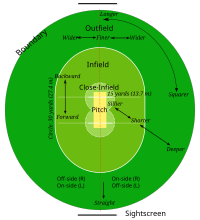
Back क्रिकेट के मैदान Bihari ক্রিকেট মাঠ Bengali/Bangla Camp de criquet Catalan Cricketfeld German Campo de críquet Spanish Terrain de cricket French ક્રિકેટનું મેદાન Gujarati क्रिकेट का मैदान Hindi ಕ್ರಿಕೆಟ್ ಮೈದಾನ Kannada Kriket alanı Turkish
 |
 |
 |
A cricket field or cricket oval is a large grass field on which the game of cricket is played. Although generally oval in shape, there is a wide variety within this: perfect circles, elongated ovals, rounded rectangles, or irregular shapes with little or no symmetry – but they will have smooth boundaries without sharp corners, almost without exception. There are no fixed dimensions for the field but its diameter usually varies between 450 and 500 feet (140 and 150 m) for men's cricket, and between 360 feet (110 m) and 420 feet (130 m) for women's cricket.
Cricket is unusual among major sports (along with golf, Australian rules football and baseball) in that there is no official rule for a fixed-shape ground for professional games. In some cases, fields are allowed to have even greater peculiarities, such as the 2.5m slope across the Lord's Cricket Ground, or the lime tree which sat inside the fence of the St Lawrence Ground.
On most grounds, a rope demarcates the perimeter of the field and is known as the boundary. Within the boundary and generally as close to the centre as possible will be the square which is an area of carefully prepared grass upon which cricket pitches can be prepared and marked for the matches. The pitch is where batsmen hit the bowled ball and run between the wickets to score runs, while the fielding team tries to return the ball to either wicket to prevent this.
© MMXXIII Rich X Search. We shall prevail. All rights reserved. Rich X Search